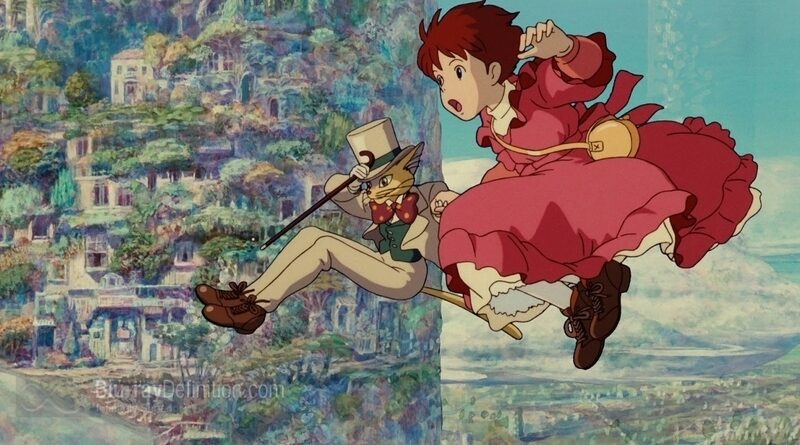Feature: Crossing the border from Whisper of the Heart to The Cat Returns
In our second edition of Studio Ghibli Sundays, Harry Jones looks at how reality and fantasy entwine over the company’s only conjoined films: Whisper of the Heart and The Cat Returns.
Be it fumbling through the trees at the bottom of the garden in My Neighbor Totoro or stumbling upon an abandoned amusement park in Spirited Away, the creative team behind Ghibli has always been concerned with the idea of crossing borders from the everyday into the magical. This idea that the imagination is a place that can be found or escaped to is something that has permeated the work of the studio since they began. There are two films, however, that deal with this jump between worlds with a divide that you can’t make in a single leap, focused on the journey of a creative, and of the inner self.
Though this transition may be one rife with a surreality that only Ghibli could dream up, it’s also one whose boundaries exists within the imagination of 14-year-old Shizuku, Whisper of the Heart‘s central character and yearning creative. Whisper of the Heart takes its title from a story Shizuku completes towards the end of the film. The main character of Shizuku’s story, The Baron, is based on a small but dapper ornamental cat she finds herself drawn to in an antique shop. The story also features a rather rotund cat by the name of “Moon” or “Muta”. This grumpy dumpling of a cat has also played a part in Shizuku’s personal life, leading her to the antique shop that plays host to The Baron earlier in the film.
These inspirations, taking part in Shizuku’s seemingly realist life in West Tokyo, act as Shizuku’s chaperones to her imaginary world of flying high with The Baron, up above the world of artist Naohisa Inoue’s nature-laden fantasy landscapes, lending an ethereal, impressionistic quality that separates Shizuku from other Ghibli animations. These brief daydreaming are just glimpses into a world that Shizuku’s created. Interesting then, that Ghibli should go down the path of exploring a world created by one of their own characters.

Now, there’s nothing saying that The Cat Returns was written by Shizuku, but Ghibli’s spin-off could certainly be an instalment in a series of stories written by her. The studio even hired manga artist Aoi Hiiragi (writer of the Whisper of the Heart manga) to write a manga alongside the making of the film, lending to the idea that The Cat Returns may be a product of a fictional character’s imagination.
The Cat Returns is Ghibli’s only spin-off, but that doesn’t mean it doesn’t stand up by itself. The film has a teenage girl of its own (Haru) at the centre of the story, but this time they take a more literal step into a new world, The Kingdom of the Cats. Where Shizuku was creating her fantasy world, Haru is led to one after saving a cat from certain death, only for it to turn out that she’s saved the life of royalty. Soon Haru is talking to cats and travelling through portals with the usual wild abandon Ghibli applies to its young go-getters.
However much The Cat Returns ticks the boxes of a Ghibli adventure, its roots as the product of a fictional character’s imagination cannot be escaped. It’s a cute idea from Ghibli, a studio that has often littered its works with bits extracted from their own canon, but in the case of these two films, it shows a divergence from their usual route of blurring fantasy and reality, one that’s unique in the studio’s filmography.
It’s worth noting that the two films in question, up until this point, were the only two Ghibli films not directed by studio founders Hayao Miyazaki or Isao Takahata. It’s easy to see, given Miyazaki’s tendency to deal with children’s imaginations coming to life and Takahata’s affection for realism, how the two films they had the least control over may find themselves dealing with similar themes, albeit via a longer route. Though Whisper of the Heart is expertly told by Yoshifumi Kondō, it cannot be denied that it is told in a vein that treads the line between Miyazaki’s fantasy and Takahata’s realism with much more precarity than Ghibli’s other films.

The absence of Miyazaki and Takahata in The Cat Returns however, is visible in a different way. Though much more in keeping with Miyazaki’s work, it fails in deftly depicting its magical worlds and confine-escaping teenagers. At the lean runtime of 75 minutes, The Cat Returns cannot muster up the depth of feeling and rich thematics of some of the studio’s other fantasies. Instead of feeling like the fertile and abundant, triumphantly realised worlds of Princess Mononoke or Castle in the Sky, The Cat Returns, even with its vibrancy, feels like a staler affair.
This misstep in the Ghibli oeuvre isn’t necessarily down to its lack of visual delight or creative energy, but its tired inception. Much as sequels exist through their originals, it’s worth drawing a line between Whisper of the Heart and The Cat Returns and asking: “Is this a necessary venture?” This roundabout transition from reality to fantasy was likely unintentional when Whisper was made, and the journey The Baron takes is arguably more interesting than his eventual destination, but I can’t help wondering whether or not it should’ve been told at all.
The line Ghibli ended up drawing between Whisper of the Heart and The Cat Returns may not have been drawn as an experiment in border-crossing but the two films hold a curious position in the Ghibli back catalogue. If nothing else, this loose duology acts as a way of highlighting just how important stepping into new worlds is as a means of telling stories.
You can find (nearly) all of Studio Ghibli’s works on Netflix. Remember! Subtitles over dubs every time.
Like this? Try these…
- Feature: Spirited Away and Miyazaki’s pitch perfect critique of capitalism
- TV review: As a dynasty collapses, The Last Dance cements its legends
- Feature: Fleabag Live, and the shifting shape of the strong female lead
- TV review: ITV’s Quiz reminded us of the unifying magic of television
- We need to support independent businesses more than ever before
- TV review: Sunderland ‘Til I Die is another end-to-end thriller

